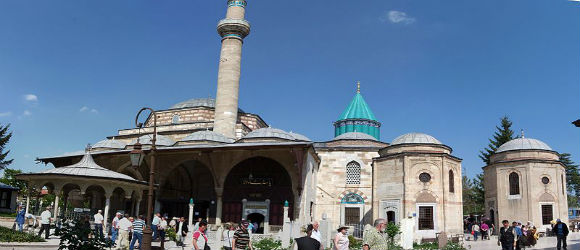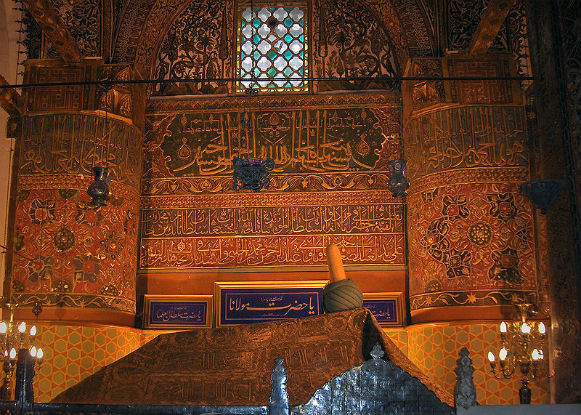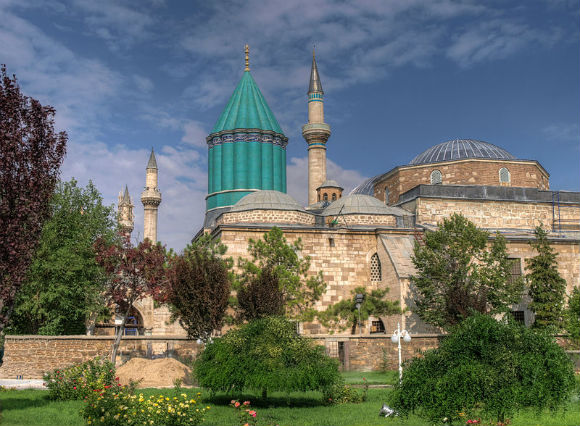The Mevlana Museum also known as the Green Mausoleum or Green Dome, is the original lodge of the Mevlevi Whirling Dervishes, a mystical Sufi Muslim group. It containes the tomb and shrine of the Mevlana, or Rumi, which remains an important place of pilgrimage.
History
Sultan ‘Ala’ al-Din Kayqubad, the Seljuk sultan who had invited Mevlana to Konya, offered his rose garden as a fitting place to bury Baha’ ud-Din Walad (or Bahaeddin Veled), the father of Mevlana, when he died in 1231. When Mevlana himself died on December 17, 1273, he was buried next to his father.
Mevlana’s successor Hüsamettin Çelebi built a mausoleum (Kubbe-i-Hadra) over the grave of his master. The Seljuk construction, under architect Behrettin Tebrizli, was finished in 1274. Gürcü Hatun, the wife of the Seljuk Emir Suleyman Pervane, and Emir Alameddin Kayser funded the construction.
The cylindrical drum of the of the dome originally rested on four pillars. The conical dome is covered with turquoise faience. Several sections were added until 1854. Selim I decorated the interior and performed the woodcarving of the catafalques.
A decree by Ataturk in September 1925 dissolved all Sufi brotherhoods in Turkey. On April 6, 1926, another decree ordered that the Mevlana mausoleum and dervish lodge be turned into a museum. The museum opened on March 2, 1927.
Special permission granted by the Turkish government in 1954 allowed the Mawlawi dervishes of Konya to perform their ritual dances for tourists for two weeks each year. Despite government opposition the order has continued to exist in Turkey as a religious body. The tomb of Rumi, although officially part of a museum, attracts a steady stream of pilgrims.
What to See
The dervish lodge (tekke) includes a semahane, where the ritual sema or whirling ceremony takes place, a sadirvan for ritual ablutions, a library, living and teaching quarters, and the mausoleum housing the tomb of Celaleddin Rumi, founder of the sect and later awarded the honorable title of Mevlana. His epitaph reads: “Do not seek our tombs on this earth – our tombs are in the hearts of the enlightened.”
The mausoleum room is highly ornamented with Islamic script and enameled reliefs, and contains the tombs of several of the more important figures of the dervish order. The main tomb enclosed behind a silver gate crafted in 1597 is that of Mevlana. The tomb of his father, Bahaeddin Veled, is upright and adjacent to his son’s, a position that signifies respect.
The adjoining room, or the semihane, is now a museum of Mevlana memorabilia displaying musical instruments and robes belonging to Mevlana, along with Selçuk and Ottoman objects like gold-engraved Korans from the 13th century. Among the fabulous ancient prayer rugs is the most valuable silk carpet in the world.
Mevlana Museum, Konya,




Unless you're a Mevlani enthusiat. This is not a must see. Much of the museum items are under harsh light (not good for presevation). The old Koran are interesting to see though
Mevlana musuem was our frst major attraction on our way to Cappadocia. I read few of Rumi`s poems, and had a bit of interest in the Sufi movement, but to see its birthplace in Konya was something else.
After concealing our shoes with blue like hospital hygenic plastic covering, we were told no picture taking inside, and sure enough security…
This museum is what served at the Asitane tekke or main lodge of the Mevlevi Sufi order since the 13th century. It features the tombs of the 13th century poet "Mevlana" Jelaluddin Rumi, as well as many of his family and other leading figures of the order. In the adjacent rooms are many different kinds of manuscripts. The areas that…
Spiritually perfect, Ministry of Culture and Tourism did a great job.
I visited the museum because we need to pass Konya when going to Cappadocia. I'm admirer of Rumi's poets and curious about Sema ceremony. The building is almost like a typical turkish mosque, with beautiful decorations. Inside the building are Rumi's and some respected muslim scholars' tombs. A beard of prophet Muhammad, was preserved there too. It is a popular…
Well worth a visit, interesting place and very well kept gardens. at 3Turkish lira per person entry fee well worth it to pass away a few hours.
We really liked this site. We rented the audio guide which I reccommend
My 5 friends and I loved this Museum although it is still a place of worship so there are restrictions to be followed which is completely fair. Inside just took our breath away we did not expect what we saw. Do not miss this experience.
A spiritual place, for Muslims and non-Muslims alike.
Tip: Try to avoid going there on weekends as the local population also visits then and the crowds are huge.
The exhibits were well displayed & explained. Would recommend all who visit the tomb to visit the museum.